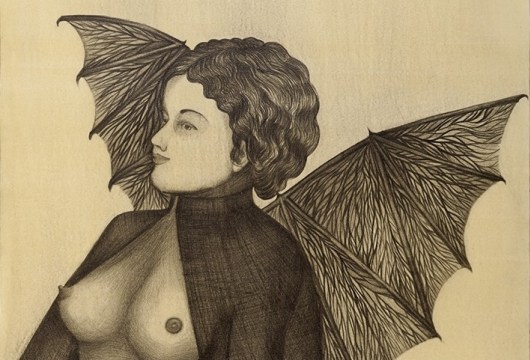
Sandra Vásquez de la Horra
América sin Fronteras (America Without Borders)
2017
graphite, watercolor, and wax on four pieces of paper
84 1/4 x 61 1/2 in
214 x 156.2 cm
SV6633
Sandra Vásquez de la Horra
Seres de Olokun (Olokun's Creatures)
2017
graphite and wax on two pieces of paper
39 1/2 x 27 3/4 in
100.3 x 70.5 cm
SV6635
Sandra Vásquez de la Horra
La verdad es demasiado grande (The Truth Is Too Big)
2017
graphite, sanguine, watercolor, and wax on two pieces of paper
52 3/4 x 40 3/8 in
134 x 102.6 cm
SV6640
Sandra Vásquez de la Horra
Señorita Bibliotecaria (The Librarian Lady)
2016
graphite, watercolor, and wax on paper
42 x 26 in
106.7 x 66 cm
SV6639
Sandra Vásquez de la Horra
Lazarus
2017
graphite, sanguine, wax crayon, and wax on four pieces of paper
84 1/2 x 62 in
214.6 x 157.5 cm
SV6634
Sandra Vásquez de la Horra
Baile Circence (Circus Dance)
2017
graphite and wax on folded paper
22 x 23 in
55.9 x 58.4 cm
SV6647
Sandra Vásquez de la Horra
Tunel II (Tunnel II)
2017
graphite, sanguine, and wax on folded paper
11 3/4 x 13 in
29.8 x 33 cm
SV6649
David Nolan Gallery is pleased to announce América sin Fronteras, an exhibition of new and recent work by Chilean artist, Sandra Vásquez de la Horra – her fourth at the gallery. On view from March 15 through April 28, the presentation will include significant drawings and three-dimensional works that testify to the artist’s vivid imagination and also the introduction of a monumental new scale into her practice.
Vásquez de la Horra (b. 1967) has become known for her deeply personal works in which she deploys a technique wherein graphite drawings are sealed over with a translucent wax “skin”, imbuing her compositions with a sense of historicity and corporeal fragility. The artist’s unique understanding of the world has been fertilised by a deep engagement with an expansive array of belief systems, both from her native Latin America and across the globe. The powerful images that inhabit her works are the result of a spontaneous and unconscious channelling of memories, metaphor, and spiritual imaginings.
The present exhibition demonstrates Vásquez de la Horra exploring the further limits of her imagination, as she takes the viewer on a journey into far flung universes, through mountain ranges, deep underwater, and finally, into the afterlife. The titular work, América sin Fronteras, 2017, a mythical seven by five foot drawing, portrays two manifestations of Mother Earth, whose recumbent body seamlessly merges into the landscape. From inside her a young boy is birthed, and armed with a bow, he goes off to hunt.
Distinctive letterforms (of the artist’s creation) appear frequently in her work, and words often literally embody her figures so as to suggest visual poetry. One such work – La verdad es demasiado grande, 2017 (or The truth is too big) – depicts an enigmatic couple engaged in a tender embrace. Vásquez de la Horra has linked the central message of this work to her own mission as an artist: to both examine and uncover the mysteries of the universe. With power and authority, the artist’s works invite us to consider more deeply the world around us, as she discerningly imparts a treasury of life’s secrets.
Work by the artist is represented in museum and public collections worldwide, including the Kupferstichkabinett, Staatliche Museen, Berlin; The Art Institute of Chicago; Denver Art Museum; Bonnefantenmuseum, Maastricht; Pinakothek der Moderne, Munich; The Morgan Library & Museum, New York; The Museum of Modern Art, New York; Musée National dʼArt Moderne, Centre Pompidou, Paris; Daniel & Florence Guerlain Contemporary Art Foundation, Paris; Philadelphia Museum of Art; Museum of Art, Rhode Island School of Design, Providence; Musée d'art moderne et contemporain, Saint-Étienne; National Gallery of Victoria, Australia; and UBS Art Collection, Zurich. Vásquez de la Horra lives and works in Berlin.
In Vásquez de la Horra’s cosmology, we encounter fantastical creatures on whatever journey we take, whether it is to a real place or an imagined future.
I first wrote about Sandra Vásquez de la Horra’s post-symbolist drawings on wax-soaked paper in the spring of 2016, when she had a show at David Nolan. As with all artists working in a highly recognizable style or vocabulary, repeating one’s symbols or making slight variations on them are pitfalls that are extremely difficult to circumvent. You might say that falling into a routine can be an occupational hazard when working with symbols, which have a tendency to remain consistent from work to work. This is not the case with Vásquez de la Horra, who keeps expanding, both formally and visually, the territory she has been exploring.
